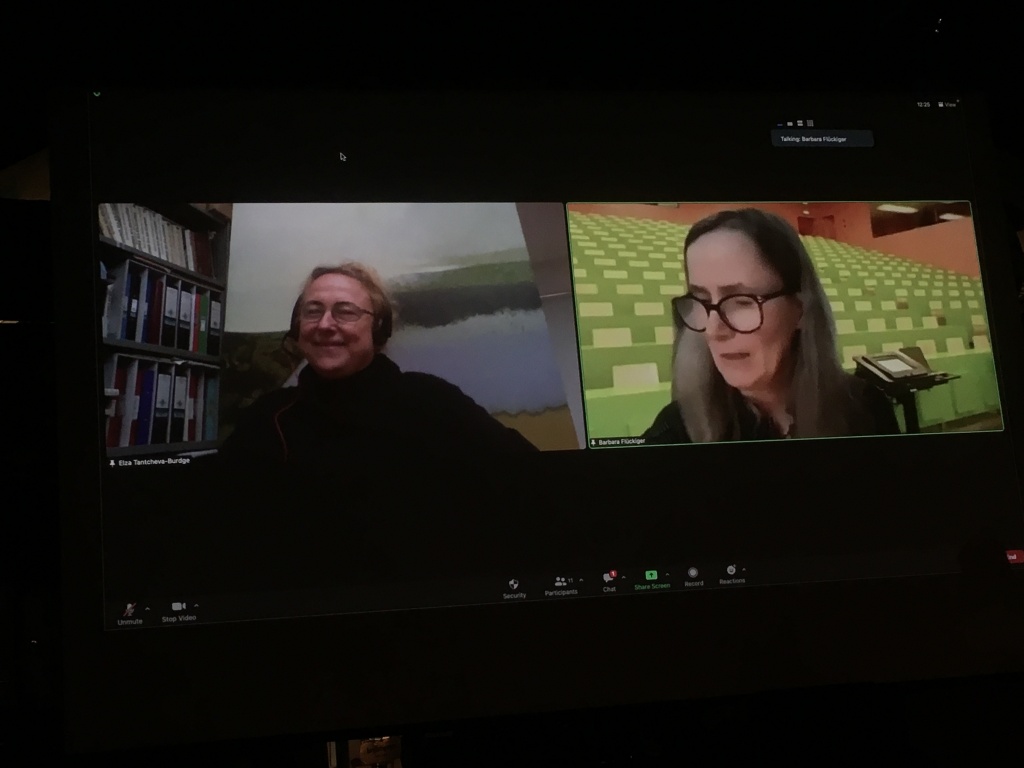
After a long Covid-induced pause, it was wonderful to see Barbara Flueckiger, Ulrich Ruedel and Elza Tantcheva-Burdge open the latest edition of the Colour in Film Conference at the Bern Lichtspiel Kinemathek, where in-person attendees also enjoyed a rare treasure trove of historic projectors, cameras, magic lanterns, and other historic artifacts that surrounded them. (Fig. 2)
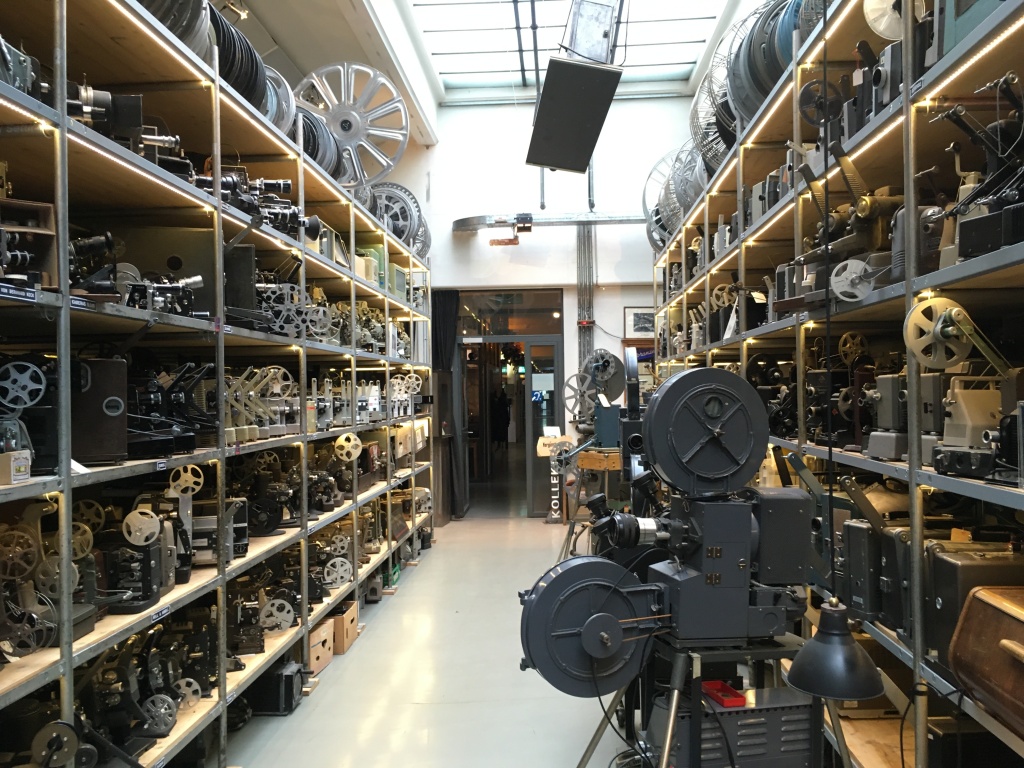
The conference began with a workshop on Colour in Analog and Digital Cinema. With a tripartite focus on color creation, distribution and exhibition, and perception, the workshop began with Laurens Orij examining the role of digital colorists and color scientists (with a particular focus on color texture), later turning to a discussion of how the creation of color transforms pipelines and workflows and appears across different output devices. Andrew Stockman guided us through a biological overview of trichromatic color perception, with a detailed examination of the role of the photoreceptors on our cones and rods (amplified in his later keynote). Charles Poynton followed with an overview of the EMAGO Color Production Pipeline, whose diagram will soon be publicly available. Further useful information can be found on the Color and Vision Research Laboratory site at www.cvrl.org.

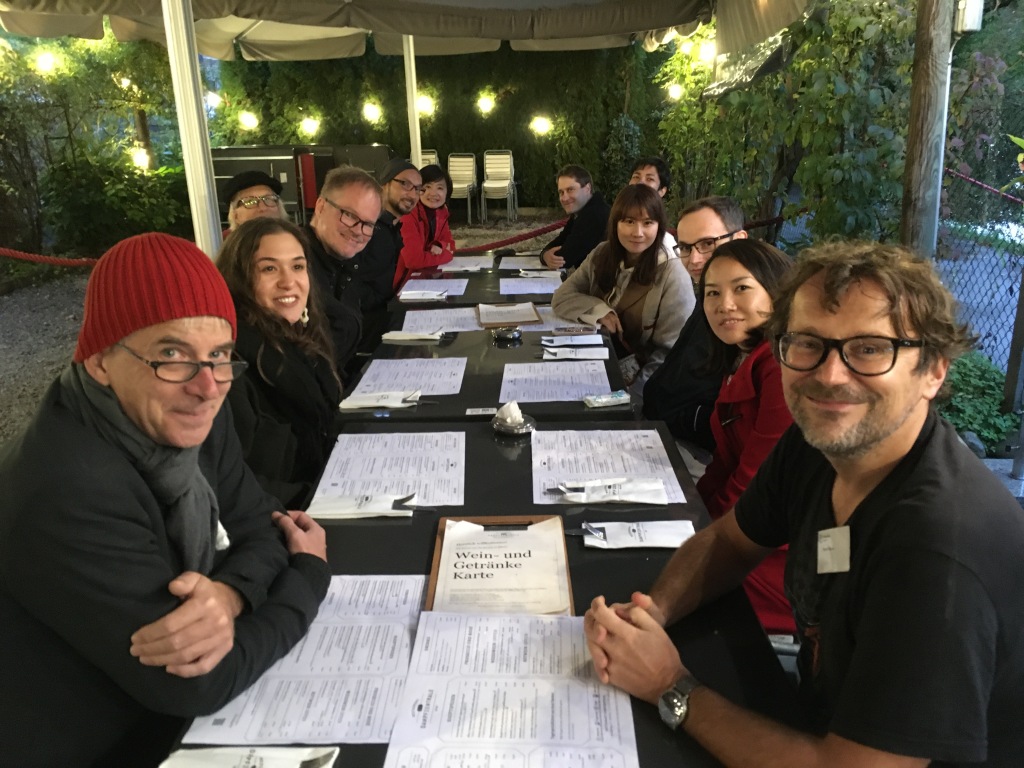
Figure 3: And now for a beer! Relaxing after the first day.
Keynote speakers Joshua Yumibe and Kirsten Thompson continued the interdisciplinary approaches established in their earlier work. Yumibe examined the long-standing role of animation and color in cinematic history through chromatropes, magic lanterns, and optical toys. He pointed to the pedagogical role that sensorial color played in early film and color theory through the work of Milton Bradley and Louis Prang, making suggestive connections between early color pedagogy and early silent film, where, for example, in the Serpentine films and Segundo de Chomón’s trick films, color seems to fall somewhere between abstraction and figurative representation, oscillating and dancing dimensionally in that middle ground between our eyes and the screen. He connected these to later experimental animation’s similar concern with color’s sensorial and haptic qualities.
My own talk developed new formal and aesthetic connections between Disney features like Dumbo, Saludos Amigos, and The Three Caballeros and the writings of Aldous Huxley and Heinrich Kramer. Looking at Heinrich Kramer’s “form constants” (specific physical patterns like kaleidoscopes, spirals, and trails that were part of the optical and neurological effects of hallucinating under the effects of mescaline), my presentation went on to suggest that critical attention to Disney’s lauded verisimilitude has overlooked a Disney surrealist tradition that is particularly evident under the constraints of wartime production and wider changes in speed and style in Forties animation.
Kristian O. Moen’s talk continued the focus on Disney by examining the use of color in background paintings and its relationship to foreground elements in cels, as well as the studio’s aesthetic and narrative approaches to color choices in several Disney Technicolor shorts of the Thirties. Drawing upon the notes taken in Don Graham’s famous Action Analysis classes at Disney during the Thirties and early Forties reveals studio discussion around the (unsuccessful) use of color in shorts like Elmer Elephant (Wilfred Jackson, 1936) and the developing aesthetic color strategies that would serve personality animation in its shorts and features.
Alla Gadassik’s stimulating talk on Len Lye opened up new areas of research by linking color studies to formal strategies in scientific films and experimental and abstract animation. Examining Len Lye’s Color Cry (1953) as her case study, along with Lye’s own reflections on consanguinity (blood kinship), Gadassik revealed the ways in which Lye’s work was influenced by representations like Popular Scientific Monthly’s representations of cells, inviting us to think through the connections between color as racial lines (drawing on W.E. Du Bois and the music of Sonny Terry) and color as biological and histological metaphors at play in Lye’s creative practice. Gadassik’s work suggestively draws upon expanded attention to nontheatrical and scientific film—recent or forthcoming texts include The Celluloid Specimen (Schultz-Figueroa, 2023), Films that Work (Hediger and Vonderau, 2009), and Animation and Advertising (Cook & Thompson, 2021)—and brings this work into conversation with postwar abstract animation and the civil rights movement.
Screenings of archival materials were particularly rich. Restoration of a collection of Segundo de Chomón from Filmoteca de Catalunya featured some canonical titles like Red Spectre (1907), which appeared in startling new form (far pinker to my eyes). Film accompaniment to this and several other programs was improvised by the marvellous Günter Buchwald on piano. Theodore Gluck, former Disney employee and current chair of the Academy of Motion Picture Arts and Sciences Technology History subcommittee, spoke about his career restoring over 30 Disney feature films and 150 shorts, raising the controversial history of the variable colors of its canonical library as they have been released across multiple platforms from film to VHS, laserdisc, DVD, and streaming, in his talk “Is Mickey’s pants really that red?”. After a brief introduction to the studio’s use of a successive exposure negative with a single focal plane in its Technicolor IV camera process, he outlined the careful work that Disney undertook to compare diacetate prints (such as Dumbo, 1941) that were cross-referenced with the Animation Research Library’s (ARL) Color Model sheets. Gluck pointed to the ways in which problems like “paint crawl” (in which pigment and binder would separate on nitrate or acetate cels) would reveal underlying material differences in gradations in color across different animated drawings and only become visible when in motion. Gluck’s talk was a rare opportunity to get an inside view into the closely guarded studio’s restoration practices.
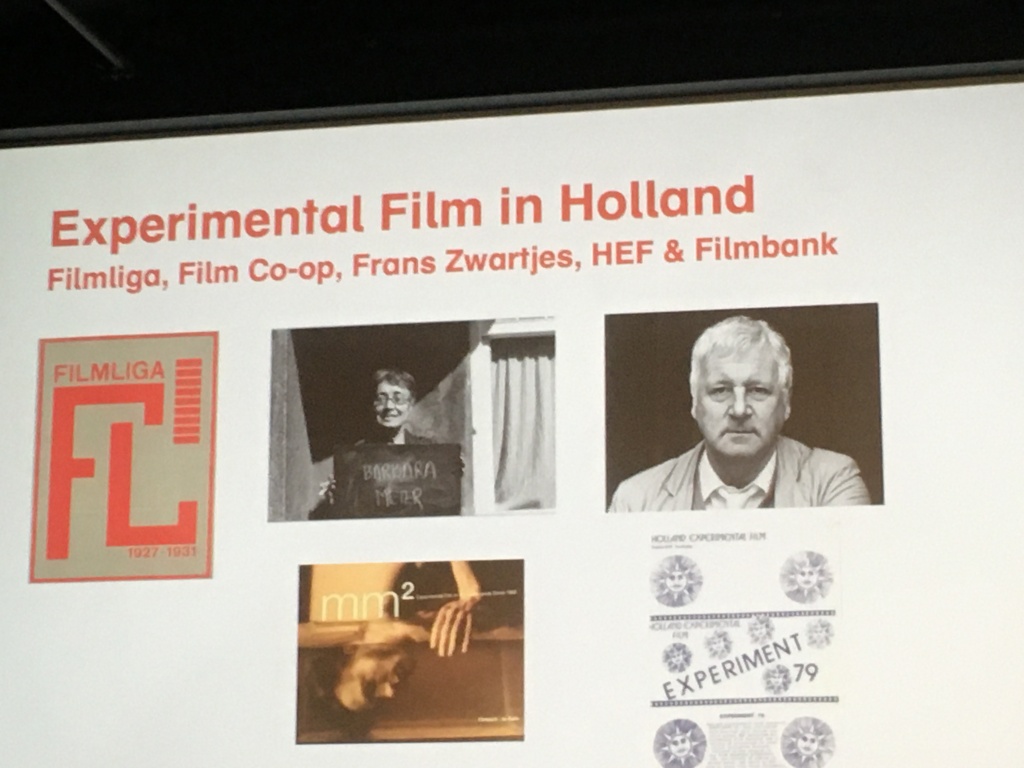
Simona Monizza’s enlightening presentation on a dimension of Amsterdam’s EYE collection called attention to the museum’s acquisition (Fig. 4) of interwar and post-WWII Dutch experimental animators, including Filmliga (a cineclub founded in 1927), Film Co-op, Frans Zwartjes, Frans Dupont, HEF and Filmbank, and others, inviting scholarly attention to this under-researched aspect of experimental animation history. Monizza’s presentation foregrounded the innovative material strategies of these experimental artists, from hand painting and scratching to filters, color strobing, collage, glitter, and hand stamping in the work of Frans Dupont (Diepte, 1933) Hi Hirsch (Gyromorphosis, 1957), Karin Wiertz and Jacques Verbeck (Slippery Slope, 1972), and José Vonk (Fences, 2009).
Jez Stewart also presented an eclectic selection of British animation from the BFI National Archive and other sources, from stop motion to cel, in a variety of different color processes (Raycol, Spectracolor, Dunningcolor, Gasparcolor and Technicolor) with a strong focus on advertising. Also strong on advertising was the restoration of 2 minutes from the Deutsches Filminstitute and Film Museum’s (DFF) print of Kaskeline Studie Nr.6 by director of animation and advertising films Wolfgang Kaskeline (often described as the “German Disney”), whose work was commissioned by cigarette company Muratti. A monograph on Kaskeline has been recently published by Herma Kennel (Als die Comics laufen lernten: Der Trickfilmpionier Wolfgang Kaskeline zwischen Werbekunst und Propaganda (Bebra Verlag, 2020). You can see some of the Kaskeline films from the collection here at filmportals.de.
Like Monizza, Curator Eva Hielscher’s talk also invited new scholarly attention, this time to the contents of the DFF’s Oskar Fischinger collection, showcasing drawings for Kreise (1933-4) and Quadrate (1934); designs for his wax-slicing machine and his special effects work on Frau im Mond; various tests made in Gasparcolor in 1933; sketches for Fantasia (rejected by Disney); and correspondence with Gasparcolor on a proposed twelve-film series.
Adding to the nontheatrical screenings were selections from the archives of the Lichtspiel Kinemathek’s rich film collection which are regularly shown as part of its weekly archival screenings. The curated screenings focused on the conference’s theme of animation, as well as its location in Switzerland. Advertising and non-theatrical film was a continuing thread, with a live action Disney-produced People and Places episode Switzerland (Ben Sharpsteen, 1956), which used color photography to foreground distinctive traditional costumes, the landscape of the Alps, national practices (cheesemaking, cow fights) and charming ethnographic oddities (folk masks, goat and cow parades). Also screened, Technicolor for Industrial Films (1945), showcased the “perfection of color that has become the keynote of Technicolor,” extolling the “eye appeal” and “realism with action” made possible by Technicolor and the ways it could spectacularize nature (“lavish in her use [of color]” and “beautiful as well as useful”). Emphasizing the texture made visible by Technicolor, the film draws attention to weave, patterns and surfaces in the color photography of textiles, and the ways in which dimensionality is enhanced through Technicolor, in which even “small differences in makeup become visible.”
Rounding out the final day was a group presentation by Giorgio Trumpy, Martin Weiss, Lutz Garmsen and David Pfluger on an ambitious new research project, Scan2Screen, that seeks to systematically desubjectivize dimensions of the color restoration process through a proposed new multispectral scanner unit custom designed for color film restoration.
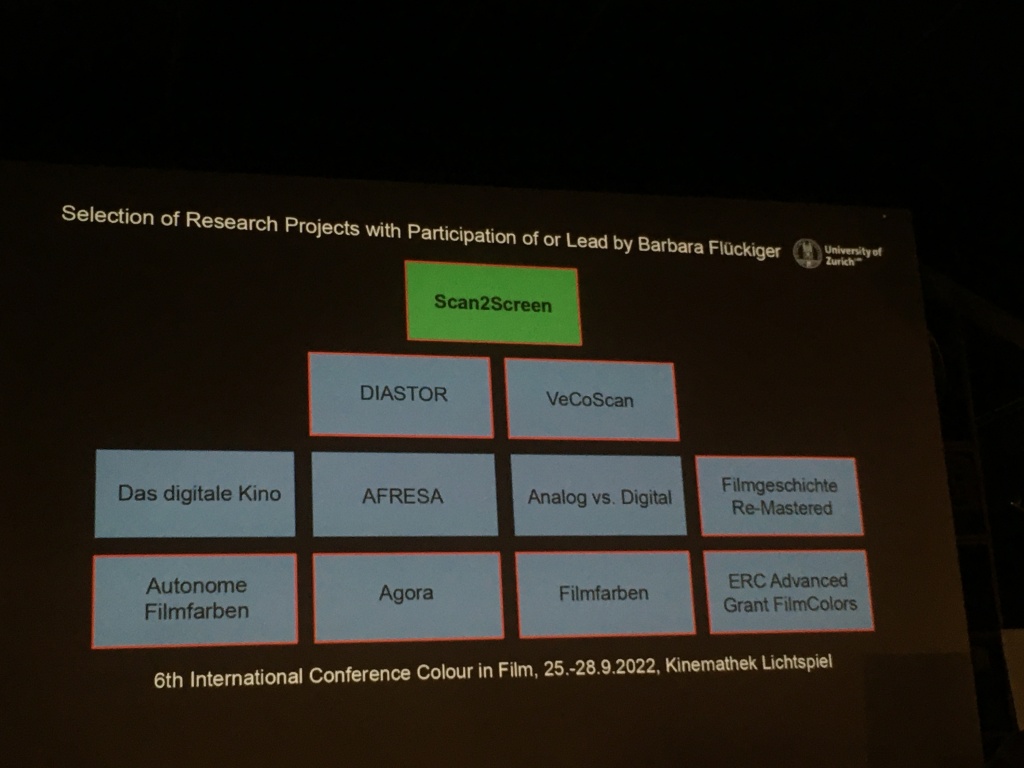
The sixth International conference Colour in Film was Barbara Flueckiger’s last as co-organizer as she heads to a well-earned retirement. Conference attendees expressed their gratitude for Barbara’s pioneering work in the field (Fig. 5) and their hopes to see her at future conferences as an attendee. A follow-up conference is planned in the next year or so, but the location has not yet been announced. Stay tuned!
Bio notes: Kirsten Moana Thompson is Professor of Film and Media and Director of the Film and Media Program at Seattle University. She teaches and writes on animation and color studies, as well as Pacific, and American studies. Recent work has focused on the animated ‘useful’ film; intersectional animated surfaces in Moana; the material color history of Disney 2D animation and the ink and paint department, and Ludwig von Drake and the Disney promotional film. She is the author of the award-winning Animation and Advertising (co-ed. M. Cook, Palgrave, 2019), the first book to examine the relationship of animation with non-theatrical media. She has also published Apocalyptic Dread: American Cinema at the Turn of the Millennium (SUNY Press, 2007); Crime Films: Investigating the Scene (Wallflower: 2007), and coedited with Terri Ginsberg Perspectives on German Cinema (GK Hall: NY, 1996). Other recent work includes “Tattooed Light and Embodied Design: Animated Surfaces in Moana” eds. Paula Massood et al in Media Crossroads: Intersections of Space and Identity in Screen Cultures (Duke UP, 2021), as well as essays on Aggie Grey and Tourism; the material color history of Disney and Faber Birren; Ludwig Von Drake and the Disney promotional film, and the animated advertising spokescharacter Reddy Kilowatt. She is currently working on three new books, Color, American Animation and Visual Culture, 1890-1960; Bubbles; and Animated America: Intermedial Promotion, from Times Square to Walt Disney.